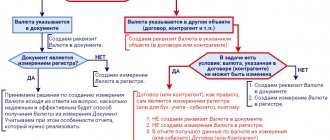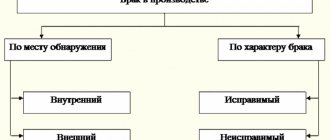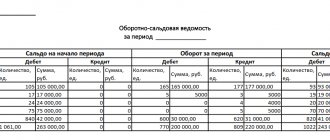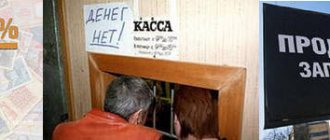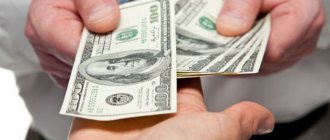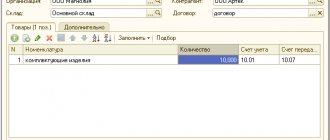The concept of materials and raw materials in accounting
These nomenclature groups include assets that can be used as semi-finished products, raw materials, components and other types of inventory assets for the production of products and services, or used for the own needs of an organization or enterprise.
Purposes of materials accounting
- Control of their safety
- Reflection in accounting of all business transactions involving the movement of inventory items (for cost planning and management and financial accounting)
- Formation of cost (materials, services, products).
- Control of standard stocks (to ensure a continuous cycle of work)
- Identification of shortages, losses, damage to materials
- Analysis of the effectiveness of the use of mineral reserves.
Account 10.02 “Purchased semi-finished products and components, structures and parts”
“Inclusion in the costs of capital construction of the cost of purchased semi-finished products, components, structures and parts”
ENTRY: Debit 08.03 “Construction of fixed assets” Credit 10.02 “Purchased semi-finished products and components, structures and parts”
Which document 1 will be made in 1c:Accounting 2.0/1c:Accounting 3.0
: -
Requirement-invoice
in the “Production” menu
“Inclusion in the cost of equipment requiring installation, the cost of purchased semi-finished products, components, structures and parts”
ENTRY: Debit 08.03 “Construction of fixed assets” Credit 10.02 “Purchased semi-finished products and components, structures and parts”
Which document 1 will be made in 1c:Accounting 2.0/1c:Accounting 3.0
: —
Requirement-invoice
in the “Production” menu
“Entering initial balances: purchased semi-finished products, components, structures and parts”
ENTRY: Debit 10.02 “Purchased semi-finished products and components, structures and parts” Credit 000 “Subsidiary account”
Which document 1 will be made in 1c:Accounting 2.0/1c:Accounting 3.0
: —
Entering initial balances
in the “Enterprise” menu, type of business transaction: “
Materials (account 10)”
“Moving between warehouses of purchased semi-finished products, components, structures and parts”
ENTRY: Debit 10.02 “Purchased semi-finished products and components, structures and parts” Credit 10.02 “Purchased semi-finished products and components, structures and parts”
Which document 1 will be made in 1c:Accounting 2.0/1c:Accounting 3.0
: —
Moving goods
to the “Warehouse” menu, type of business transaction: “
Goods, products”
“Assembly of purchased semi-finished products, components, structures and parts”
ENTRY: Debit 10.02 “Purchased semi-finished products and components, structures and parts” Credit 10.02 “Purchased semi-finished products and components, structures and parts”
Which document 1 will be made in 1c:Accounting 2.0/1c:Accounting 3.0
: —
Assembling items
in the “Warehouse” menu, type of business transaction: “
Assembling”
“Disassembly of purchased semi-finished products, components, structures and parts”
ENTRY: Debit 10.02 “Purchased semi-finished products and components, structures and parts” Credit 10.02 “Purchased semi-finished products and components, structures and parts”
Which document 1 will be made in 1c:Accounting 2.0/1c:Accounting 3.0
: —
Assembling items
in the “Warehouse” menu, type of business transaction: “
Disassembly”
“Return of purchased semi-finished products and components, structures and parts from processing”
ENTRY: Debit 10.02 “Purchased semi-finished products and components, structures and parts” Credit 10.07 “Materials transferred for external processing”
Which document 1 will be made in 1c:Accounting 2.0/1c:Accounting 3.0
: —
Receipt from processing
in the “Production” menu
“Inclusion in the price of semi-finished products, components, structures and parts of the amount of non-refundable VAT paid upon purchase”
ENTRY: Debit 10.02 “Purchased semi-finished products and components, structures and parts” Credit 19.03 “VAT on purchased inventories”
Which document 1 will be made in 1c:Accounting 2.0/1c:Accounting 3.0
: —
VAT write-off
in the menu “Purchase — Maintaining a purchase book”
“Receipt of purchased semi-finished products, components, structures and parts from the supplier. Reflection of debt to the supplier under the contract in rubles.”
ENTRY: Debit 10.02 “Purchased semi-finished products and components, structures and parts” Credit 60.01 “Settlements with suppliers and contractors”
Which document 1 will be made in 1c:Accounting 2.0/1c:Accounting 3.0
: —
Receipt of goods and type of business transaction: “ Purchase, commission”
“Inclusion in the price of purchased semi-finished products, components, structures and parts of additional expenses (services of third-party organizations for transportation, storage, etc.) under a contract in rubles.”
ENTRY: Debit 10.02 “Purchased semi-finished products and components, structures and parts” Credit 60.01 “Settlements with suppliers and contractors”
Which document 1 will be made in 1c:Accounting 2.0/1c:Accounting 3.0
: —
Receipt of additional
expenses in the "Purchase" menu
“Receipt of purchased semi-finished products, components, structures and parts from processing at the planned cost. Reflection of debt to the supplier under the contract in rubles.”
ENTRY: Debit 10.02 “Purchased semi-finished products and components, structures and parts” Credit 60.01 “Settlements with suppliers and contractors”
Which document 1 will be made in 1c:Accounting 2.0/1c:Accounting 3.0
: —
Receipt from processing
in the “Production” menu
“Receipt of purchased semi-finished products, components, structures and parts from the supplier. Reflection of debt to the supplier under the contract in foreign currency"
ENTRY: Debit 10.02 “Purchased semi-finished products and components, structures and parts” Credit 60.21 “Settlements with suppliers and contractors (in foreign currency)”
Which document 1 will be made in 1c:Accounting 2.0/1c:Accounting 3.0
: —
Receipt of goods and type of business transaction: “ Purchase, commission”
“Inclusion in the price of purchased semi-finished products, components, structures and parts of additional costs (services of third-party organizations for transportation, storage, etc.) under a contract in cu.”
ENTRY: Debit 10.02 “Purchased semi-finished products and components, structures and parts” Credit 60.21 “Settlements with suppliers and contractors (in foreign currency)”
Which document 1 will be made in 1c:Accounting 2.0/1c:Accounting 3.0
: —
Receipt of additional
expenses in the "Purchase" menu
“Receipt of purchased semi-finished products, components, structures and parts from processing at the planned cost. Reflection of debt to the supplier under the contract in foreign currency"
ENTRY: Debit 10.02 “Purchased semi-finished products and components, structures and parts” Credit 60.21 “Settlements with suppliers and contractors (in foreign currency)”
Which document 1 will be made in 1c:Accounting 2.0/1c:Accounting 3.0
: —
Receipt from processing
in the “Production” menu
“Receipt of purchased semi-finished products, components, structures and parts from the supplier. Reflection of debt to the supplier under the contract in monetary units.”
ENTRY: Debit 10.02 “Purchased semi-finished products and components, structures and parts” Credit 60.31 “Settlements with suppliers and contractors (in cu)”
Which document 1 will be made in 1c:Accounting 2.0/1c:Accounting 3.0
: —
Receipt of goods and type of business transaction: “ Purchase, commission”
“Inclusion in the price of purchased semi-finished products, components, structures and parts of additional costs (services of third-party organizations for transportation, storage, etc.) under a contract in cu.”
ENTRY: Debit 10.02 “Purchased semi-finished products and components, structures and parts” Credit 60.31 “Settlements with suppliers and contractors (in cu)”
Which document 1 will be made in 1c:Accounting 2.0/1c:Accounting 3.0
: —
Receipt of additional
expenses in the "Purchase" menu
“Receipt of purchased semi-finished products, components, structures and parts from processing at the planned cost. Reflection of debt to the supplier at the planned cost under the contract in monetary units.”
ENTRY: Debit 10.02 “Purchased semi-finished products and components, structures and parts” Credit 60.31 “Settlements with suppliers and contractors (in cu)”
Which document 1 will be made in 1c:Accounting 2.0/1c:Accounting 3.0
: —
Receipt from processing
in the “Production” menu
“Acceptance for accounting of purchased semi-finished products, components, structures and parts under a short-term loan agreement in rubles.”
ENTRY: Debit 10.02 “Purchased semi-finished products and components, structures and parts” Credit 66.03 “Short-term loans”
Which document 1 will be made in 1c:Accounting 2.0/1c:Accounting 3.0
: —
Operation (accounting and tax accounting)
in the menu “Operations — Operations entered manually”
“Acceptance for accounting of purchased semi-finished products, components, structures and parts under a long-term loan agreement in rubles.”
ENTRY: Debit 10.02 “Purchased semi-finished products and components, structures and parts” Credit 67.03 “Long-term loans”
Which document 1 will be made in 1c:Accounting 2.0/1c:Accounting 3.0
: —
Operation (accounting and tax accounting)
in the menu “Operations — Operations entered manually”
“Acceptance for accounting of purchased semi-finished products, components, structures and parts received from an accountable entity in rubles.”
ENTRY: Debit 10.02 “Purchased semi-finished products and components, structures and parts” Credit 71.01 “Settlements with accountable persons”
Which document 1 will be made in 1c:Accounting 2.0/1c:Accounting 3.0
: —
Advance report
in the “Cashier” menu
“Acceptance for accounting of purchased semi-finished products, components, structures and parts received from an employee of the organization to pay off debt for compensation for material damage”
ENTRY: Debit 10.02 “Purchased semi-finished products and components, structures and parts” Credit 73.02 “Calculations for compensation for material damage”
Which document 1 will be made in 1c:Accounting 2.0/1c:Accounting 3.0
: —
Operation (accounting and tax accounting)
in the menu “Operations — Operations entered manually”
“Acceptance for accounting of purchased semi-finished products, components, structures and parts received as a contribution to the authorized capital”
ENTRY: Debit 10.02 “Purchased semi-finished products and components, structures and parts” Credit 75.01 “Calculations for contributions to the authorized (share) capital”
Which document 1 will be made in 1c:Accounting 2.0/1c:Accounting 3.0
: —
Operation (accounting and tax accounting)
in the menu “Operations — Operations entered manually”
“Inter-branch receipt of purchased semi-finished products, components, structures and parts from a separate division allocated to a separate balance sheet”
ENTRY: Debit 10.02 “Purchased semi-finished products and components, structures and parts” Credit 79.02 “Calculations for current operations”
Which document 1 will be made in 1c:Accounting 2.0/1c:Accounting 3.0
: —
Advice on inventories included
in the “Warehouse” menu
“Surplus of purchased semi-finished products, components, structures and parts identified as a result of inventory. Recognition of other income"
ENTRY: Debit 10.02 “Purchased semi-finished products and components, structures and parts” Credit 91.01 “Other income”
Which document 1 will be made in 1c:Accounting 2.0/1c:Accounting 3.0
: —
Receipt of goods
in the “Warehouse” menu
“Acceptance for accounting of purchased semi-finished products, components, structures and parts received free of charge, incl. under a gift agreement"
ENTRY: Debit 10.02 “Purchased semi-finished products and components, structures and parts” Credit 98.02 “Gratuitous receipts”
Which document 1 will be made in 1c:Accounting 2.0/1c:Accounting 3.0
: —
Operation (accounting and tax accounting)
in the menu “Operations — Operations entered manually”
“Transfer of purchased semi-finished products and components, structures and parts for processing”
ENTRY: Debit 10.07 “Materials transferred for processing to third parties” Credit 10.02 “Purchased semi-finished products and components, structures and parts”
Which document 1 will be made in 1c:Accounting 2.0/1c:Accounting 3.0
: —
Transfer of goods
to the “Production” menu, type of business transaction: “
Transfer of raw materials for processing”
“Transfer of purchased semi-finished products and components, structures and parts for processing”
ENTRY: Debit 10.07 “Materials transferred for processing to third parties” Credit 10.02 “Purchased semi-finished products and components, structures and parts”
Which document 1 will be made in 1c:Accounting 2.0/1c:Accounting 3.0
: —
Receipt from processing
in the “Production” menu
“Write-off of the cost of purchased semi-finished products, components, structures and parts as main production costs”
ENTRY: Debit 20.01 “Main production” Credit 10.02 “Purchased semi-finished products and components, structures and parts”
Which document 1 will be made in 1c:Accounting 2.0/1c:Accounting 3.0
: —
Requirement-invoice
in the “Production” menu
“Adjustment of the cost of purchased semi-finished products, components, structures and parts written off as main production costs”
ENTRY: Debit 20.01 “Main production” Credit 10.02 “Purchased semi-finished products and components, structures and parts”
Which document 1 will be made in 1c:Accounting 2.0/1c:Accounting 3.0
: —
Regular operation
in the menu “Operations — Closing the month” type of business transaction: “
Adjustment of item cost”
“Acceptance for accounting of returnable waste from main production: purchased semi-finished products, components, structures and parts at prices of possible use or sale (reversal)”
ENTRY: Debit 20.01 “Main production” Credit 10.02 “Purchased semi-finished products and components, structures and parts”
Which document 1 will be made in 1c:Accounting 2.0/1c:Accounting 3.0
: —
Operation (accounting and tax accounting)
in the menu “Operations — Operations entered manually”
“Write-off of the cost of purchased semi-finished products, components, structures and parts for the costs of auxiliary production”
ENTRY: Debit 23 “Auxiliary production” Credit 10.02 “Purchased semi-finished products and components, structures and parts”
Which document 1 will be made in 1c:Accounting 2.0/1c:Accounting 3.0
: —
Requirement-invoice
in the “Production” menu
“Adjustment of the cost of purchased semi-finished products, components, structures and parts written off as auxiliary production costs”
ENTRY: Debit 23 “Auxiliary production” Credit 10.02 “Purchased semi-finished products and components, structures and parts”
Which document 1 will be made in 1c:Accounting 2.0/1c:Accounting 3.0
: —
Regular operation
in the menu “Operations — Closing the month” type of business transaction: “
Adjustment of item cost”
“Acceptance for accounting of returnable waste from auxiliary production: purchased semi-finished products, components, structures and parts at prices of possible use or sale (reversal)”
ENTRY: Debit 23 “Auxiliary production” Credit 10.02 “Purchased semi-finished products and components, structures and parts”
Which document 1 will be made in 1c:Accounting 2.0/1c:Accounting 3.0
: —
Operation (accounting and tax accounting)
in the menu “Operations — Operations entered manually”
“Write-off of the cost of purchased semi-finished products, components, structures and parts for general production expenses”
ENTRY: Debit 25 “General production expenses” Credit 10.02 “Purchased semi-finished products and components, structures and parts”
Which document 1 will be made in 1c:Accounting 2.0/1c:Accounting 3.0
: —
Requirement-invoice
in the “Production” menu
“Adjustment of the cost of purchased semi-finished products, components, structures and parts written off as general production expenses”
ENTRY: Debit 25 “General production expenses” Credit 10.02 “Purchased semi-finished products and components, structures and parts”
Which document 1 will be made in 1c:Accounting 2.0/1c:Accounting 3.0
: —
Regular operation
in the menu “Operations — Closing the month” type of business transaction: “
Adjustment of item cost”
“Write-off of the cost of purchased semi-finished products, components, structures and parts for general business expenses”
ENTRY: Debit 26 “General business expenses” Credit 10.02 “Purchased semi-finished products and components, structures and parts”
Which document 1 will be made in 1c:Accounting 2.0/1c:Accounting 3.0
: —
Requirement-invoice
in the “Production” menu
“Adjustment of the cost of purchased semi-finished products, components, structures and parts written off as general business expenses”
ENTRY: Debit 26 “General business expenses” Credit 10.02 “Purchased semi-finished products and components, structures and parts”
Which document 1 will be made in 1c:Accounting 2.0/1c:Accounting 3.0
: —
Regular operation
in the menu “Operations — Closing the month” type of business transaction: “
Adjustment of item cost”
“Write-off of the cost of purchased semi-finished products, components, structures and parts for the correction of defects for the correction of defects”
ENTRY: Debit 28 “Defects in production” Credit 10.02 “Purchased semi-finished products and components, structures and parts”
Which document 1 will be made in 1c:Accounting 2.0/1c:Accounting 3.0
: —
Requirement-invoice
in the “Production” menu
“Write-off of the cost of purchased semi-finished products, components, structures and parts to correct defects”
ENTRY: Debit 28 “Defects in production” Credit 10.02 “Purchased semi-finished products and components, structures and parts”
Which document 1 will be made in 1c:Accounting 2.0/1c:Accounting 3.0
: —
Requirement-invoice
in the “Production” menu
“Write-off of the cost of purchased semi-finished products, components, structures and parts for the costs of service industries and farms”
ENTRY: Debit 29 “Service production and facilities” Credit 10.02 “Purchased semi-finished products and components, structures and parts”
Which document 1 will be made in 1c:Accounting 2.0/1c:Accounting 3.0
: —
Requirement-invoice
in the “Production” menu
“Adjustment of the cost of purchased semi-finished products, components, structures and parts written off as costs of service industries and farms”
ENTRY: Debit 29 “Service production and facilities” Credit 10.02 “Purchased semi-finished products and components, structures and parts”
Which document 1 will be made in 1c:Accounting 2.0/1c:Accounting 3.0
: —
Regular operation
in the menu “Operations — Closing the month” type of business transaction: “
Adjustment of item cost”
“Write-off of the cost of purchased semi-finished products, components, structures and parts as business expenses in organizations engaged in industrial and other production activities”
ENTRY: Debit 44.02 “Business expenses in organizations engaged in industrial and other production activities” Credit 10.02 “Purchased semi-finished products and components, structures and parts”
Which document 1 will be made in 1c:Accounting 2.0/1c:Accounting 3.0
: —
Requirement-invoice
in the “Production” menu
“Adjustment of the cost of purchased semi-finished products, components, structures and parts written off as business expenses in organizations engaged in industrial and other production activities”
ENTRY: Debit 44.02 “Business expenses in organizations engaged in industrial and other production activities” Credit 10.02 “Purchased semi-finished products and components, structures and parts”
Which document 1 will be made in 1c:Accounting 2.0/1c:Accounting 3.0
: —
Regular operation
in the menu “Operations — Closing the month” type of business transaction: “
Adjustment of item cost”
“Shipment of purchased semi-finished products, components, structures and parts to the third party without transfer of ownership”
ENTRY: Debit 45.03 “Other goods shipped” Credit 10.02 “Purchased semi-finished products and components, structures and parts”
Which document 1 will be made in 1c:Accounting 2.0/1c:Accounting 3.0
: —
Sales of goods and type of business transaction: “ Shipment without transfer of ownership”
“Transfer of purchased semi-finished products, components, structures and parts to commission (accounting with the consignor)”
ENTRY: Debit 45.03 “Other goods shipped” Credit 10.02 “Purchased semi-finished products and components, structures and parts”
Which document 1 will be made in 1c:Accounting 2.0/1c:Accounting 3.0
: —
Sales of goods and type of business transaction: “ Sale, commission”
“Reflection of the amount of claims presented to the supplier in connection with the identification of discrepancies in prices and tariffs, arithmetic errors in calculating the cost of purchased semi-finished products, components, structures and parts”
ENTRY: Debit 76.02 “Calculations for claims” Credit 10.02 “Purchased semi-finished products and components, structures and parts”
Which document 1 will be made in 1c:Accounting 2.0/1c:Accounting 3.0
: —
Operation (accounting and tax accounting)
in the menu “Operations — Operations entered manually”
“Return of purchased semi-finished products, components, structures and parts to the supplier under a contract in rubles.”
ENTRY: Debit 76.02 “Calculations for claims” Credit 10.02 “Purchased semi-finished products and components, structures and parts”
Which document 1 will be made in 1c:Accounting 2.0/1c:Accounting 3.0
: —
Return of goods to the supplier
in the “Purchase” menu, type of business transaction: “
Purchase, commission”
“Inter-branch transfer of purchased semi-finished products, components, structures and parts to a separate division allocated to a separate balance sheet”
ENTRY: Debit 79.02 “Calculations for current operations” Credit 10.02 “Purchased semi-finished products and components, structures and parts”
Which document 1 will be made in 1c:Accounting 2.0/1c:Accounting 3.0
: —
Inventory advice note outgoing
in the “Warehouse” menu
“Transfer of purchased semi-finished products, components, structures and parts free of charge”
ENTRY: Debit 91.02 “Other expenses” Credit 10.02 “Purchased semi-finished products and components, structures and parts”
Which document 1 will be made in 1c:Accounting 2.0/1c:Accounting 3.0
: —
Operation (accounting and tax accounting)
in the menu “Operations — Operations entered manually”
“Write-off of the cost of purchased semi-finished products, components, structures and parts sold to the buyer”
ENTRY: Debit 91.02 “Other expenses” Credit 10.02 “Purchased semi-finished products and components, structures and parts”
Which document 1 will be made in 1c:Accounting 2.0/1c:Accounting 3.0
: —
Sales of goods and type of business transaction: “ Sale, commission”
“Return of the cost of purchased semi-finished products, components, structures and parts from the buyer during the reporting period (reversal)”
ENTRY: Debit 91.02 “Other expenses” Credit 10.02 “Purchased semi-finished products and components, structures and parts”
Which document 1 will be made in 1c:Accounting 2.0/1c:Accounting 3.0
: —
Return of goods from the buyer
in the “Sale” menu, type of business transaction: “
Sale, commission”
“Write-off (liquidation) of the cost of purchased semi-finished products, components, structures and parts as a result of natural disasters, fires and other emergency circumstances”
ENTRY: Debit 91.02 “Other expenses” Credit 10.02 “Purchased semi-finished products and components, structures and parts”
Which document 1 will be made in 1c:Accounting 2.0/1c:Accounting 3.0
: —
Operation (accounting and tax accounting)
in the menu “Operations — Operations entered manually”
“Shortage of purchased semi-finished products, components, structures and parts”
ENTRY: Debit 94 “Shortages and losses from damage to valuables” Credit 10.02 “Purchased semi-finished products and components, structures and parts”
Which document 1 will be made in 1c:Accounting 2.0/1c:Accounting 3.0
: —
Write-off of goods
in the “Warehouse” menu, type of business transaction: “
Goods, products”
Subaccounts 10 accounts
PBUs establish a list of certain accounting accounts in the Chart of Accounts that should be used to account for materials in accordance with their classification and item groups.
Depending on the specifics of the activity (budgetary organization, manufacturing enterprise, trade, etc.) and accounting policies, accounts may be different.
The main account is account 10, to which the following sub-accounts can be opened:
| Subaccounts to the 10th account | Name of material assets | A comment |
| 10.01 | Raw materials | |
| 10.02 | Semi-finished products, components, parts and structures (purchased) | For the production of products, services and own needs |
| 10.03 | Fuel, fuel and lubricants | |
| 10.04 | Container materials, packaging | |
| 10.05 | Spare parts | |
| 10.06 | Other materials (for example: stationery) | For production purposes |
| 10.07, 10.08, 10.09, 10.10 | Materials for processing (outside), Construction materials, Household supplies, equipment, Working clothes, equipment (in warehouse) |
The chart of accounts classifies materials according to product groups and the method of inclusion in a certain cost group (construction, production of own products, maintenance of auxiliary production and others, the table shows the most used ones).
Opening sub-accounts for account 10
Order of the Ministry of Finance No. 94n determines that in order to organize complete, reliable and detailed accounting of the company’s material assets, the opening of additional sub-accounts is provided. This approach allows you to group all the organization’s inventory items by type.
| Number | Name | Content |
| 10.1 | Raw materials | Reflect material assets that are used to carry out the main activity |
| 10.2 | Semi-finished products | Components, components, structures and parts that are used in the main and auxiliary production cycles and processes |
| 10.3 | Fuel | Fuel and lubricants, gasoline, diesel fuel, gas, motor oils, etc. |
| 10.4 | Tara | Materials used as containers and (or) packaging |
| 10.5 | Spare parts | Spare parts used for repair and maintenance |
| 10.6 | Other inventories | Values not included in other groups |
| 10.7 | Materials for external processing | MPZ intended for external processing |
| 10.8 | Construction materials | To reflect information about the availability and movement of building materials from developers |
| 10.9 | Household equipment | Materials and equipment, accessories and equipment used to perform general economic work |
Please note that opening all accounts is not necessary. The organization independently decides which subaccounts will be used in accounting. So, for example, account 10.10 - what applies to a particular institution must be defined in the accounting policy. Typically, special equipment (special equipment) is included in this subaccount.
Correspondence on account 10
The debit of 10 accounts in the postings corresponds with production and auxiliary accounts (on credit):
- 20.01 (main production)
- 23 (auxiliary)
- 25 (general production)
- 26 (general economic, management)
Besides them:
- 44 (sales expenses)
- 45 (shipped goods)
- 76 (settlements with debtors and creditors)
- 94 (shortages and losses)
- 99 (profit and loss)
- And others - according to the chart of accounts and accounting policies.
Characteristics
To account for raw materials and materials, primary documentation forms are used, which can be either of a unified form or be an independent development of the enterprise, subject to the use of details approved by law. Materials can be written off in accordance with PBU 5/01 in one of three ways:
- At average cost.
- At the cost of each individual unit.
- FIFO method.
Invoice analysis occurs in the context of items, warehouses, divisions and batches. The account characteristics may show that inventory is written off on a loan based on supporting primary documentation. Receipt is by debit. Thus, answering the question of which account is passive or active is not difficult. Accounting account 10 is active and has a debit balance.
Additional Information! The account balance can be determined by adding the opening balance to the debit turnover and subtracting the account credit from it.
Accounting for inventory items in accounting: postings and documents
Accounting for inventory items in accounting is reflected on the basis of primary documentation and can be as follows:
- The purchase of materials is made in cash or by bank transfer, confirmed by a purchase agreement, payment and settlement documents or the transfer of a power of attorney to receive goods and materials with subsequent settlement with the supplier. It is received at the warehouse on the basis of a bill of lading or a receipt order. When purchasing materials, additional transportation and procurement costs (for example, delivery) may be reflected.
- Sale of materials - transfer of raw materials to third parties.
- Transfer - from the founders, contractors or sponsors, is accounted for at the estimated value or on the basis of available documents: contracts, payment documents, appraisal reports, etc.
- Write-off of materials - reflects the expenditure of inventory and materials into production. It may imply both the write-off of materials for actual production and the write-off for general business needs. Depends on corr. accounts (20, 23, 25, 26). Disposal may be reflected due to damage or loss of inventory items.
- Shortage of materials or surplus of materials are recorded as a result of inventory. They may be reflected within the normal limits or as a result of loss/damage.
- Operations with customer-supplied raw materials - features of accounting for materials received from another organization.
For production and for own needs, materials are released from the warehouse upon request - invoice or other documents (based on accounting policies); are written off to the production site, which then includes them in the cost of products or services.
Carrying out inventories
Every year, according to PBU, owners are required to conduct scheduled inventories on the basis of an issued order with designated responsible persons. In addition to them, there may be unscheduled (sudden) audits and inventories. Their goal: control over the safety and correct use and write-off of inventory items .
Postings for receipt and disposal of materials
There are several ways for materials to enter an organization: acquisition for a fee, acceptance as a contribution from the founders, production of materials, free receipt, etc.
Depending on the method of receipt, the following postings for materials appear in accounting.
| Debit | Credit | Contents of operation |
| 10 | 60, 76 | Receipt of the invoice from the supplier; Wholesale supply of goods is carried out under a sales contract |
| 10 | 71 | Acquisition of inventories by an accountable person |
| 10 | 75 | Founder's contribution; the estimated value of the property must be agreed upon with the person contributing the property |
| 10 | 91 | Reflected gratuitous receipt; In this case, the market value of the material is taken as the amount. A similar posting is made when taking into account materials received during the dismantling of fixed assets |
If upon receipt the cost of the material includes VAT, then its amount is reflected in a separate line.
Example 3
Motiv LLC purchased a batch of paper (100 packs) for office needs using an invoice for a total amount of 18,000 rubles, including VAT 20% of 3,000 rubles. The organization made the following entries:
| Debit | Credit | Amount, rub. | Contents of operation |
| 10.6 | 60 | 15 000 | A batch of paper has arrived |
| 19.3 | 60 | 3 000 | The amount of input VAT is reflected |
| 68.2 | 19.3 | 3 000 | VAT amount accepted for refund |
| 60 | 51 | 18 800 | Payment was made to the supplier through a bank account |
For more information on the formation of VAT when purchasing inventories, see the material “How is VAT recorded on purchased assets?” .
If an organization applies a taxation regime that excludes the use of VAT (STS, UTII), then the entire cost of materials should be credited to account 10. In this case, VAT does not apply to refundable taxes, but is taken into account when determining the cost price.
The release of inventories to third parties can be carried out for the following number of reasons:
| Debit | Credit | Contents of operation |
| 20, 23, 25, 26, 29, 44 | 10 | Issue from a warehouse for production or general business needs of the organization; transfer is carried out using limit-fence cards or requirements-invoices |
| 94 | 10 | The gratuitous write-off of materials as a result of damage or theft is reflected. As a rule, a lack of food supplies is identified as a result of an inventory; an act of write-off of materials is drawn up |
| 99 | 10 | The materials were lost due to a natural disaster; the transaction is reflected using a write-off statement |
| 91 | 10 | Reflection of the transfer (sale) of materials to the third party; actual cost is used |
Postings to inventory items
Materials are accounted for in account 10, which has subaccounts depending on their type (materials, semi-finished products, fuels and lubricants, inventory, others, etc.). In its accounting policy, the organization must establish how it will reflect accounting: simply at actual cost or at accounting prices (in this case, it is necessary to use accounts 15 and).
In order to write off materials, they also choose their own method in the accounting policy. There are three of them:
- at average cost;
- at cost of inventories;
- FIFO.
Materials are released into production or for general business needs. Situations are also possible when surpluses are sold, and defects, losses or shortages are written off.
Control over the movement of economic and production equipment transferred to operation
We have already said above that assets that meet the criteria for classification as fixed assets and are valued within the limit established by the organization, but not more than 40,000 rubles, can be reflected in the accounting system as part of the inventory. At the same time, clause 5 of PBU 6/01 directly requires that the organization is obliged to establish control over them in order to track their movement and ensure safety after they are put into operation.
Such property, as a rule, is accounted for on account 10.09 and its value is written off at a time when it is put into operation. At the same time, this property must continue to be taken into account off the balance sheet until it is completely worn out or lost. For this, as a rule, account MC.04 is used. When writing off an off-balance sheet, you need to draw up an act in the MB-8 form.
A sample act MB-8 was prepared by ConsultantPlus experts. Get free trial access to the system and proceed to the sample.
As for the MCs related to the MPZ, the organization is not obliged to establish control over their movement, but can do this, guided by its interests.
How exactly control over inventory should be exercised has not been determined by anyone. The organization itself develops norms and rules for its implementation.
This is often done using a separate off-balance sheet account, for example 012, on which they keep records of inventory transferred into operation (Dt 012) until it is written off due to expiration of its service life, sale, loss, etc. (Dt 012) .
Example of postings on account 10
The Alpha organization bought 270 sheets of iron from Omega. The cost of materials was 255,690 rubles. (VAT 18% - 39,004 rubles). Subsequently, 125 sheets were released into production at average cost, another 3 were damaged and written off as scrap (write-off at actual cost within the limits of natural loss norms).
Cost formula:
Average cost = ((Cost of remaining materials at the beginning of the month + Cost of materials received for the month) / (Number of materials at the beginning of the month + Number of materials received)) x number of units released into production
Average cost in our example = (216686/270) x 125 = 100318
Let's reflect this cost in our example:
| Account Dt | Kt account | Wiring Description | Transaction amount | A document base |
| 60.01 | 51 | Paid for materials | 255 690 | Bank statement |
| 10.01 | 60.01 | Receipt of materials to the warehouse from the supplier | 216 686 | Request-invoice |
| 19.03 | 60.01 | VAT included | 39 004 | Packing list |
| 68.02 | 19.03 | VAT is accepted for deduction | 39 004 | Invoice |
| 20.01 | 10.01 | Posting: materials released from warehouse to production | 100 318 | Request-invoice |
| 94 | 10.01 | Writing off the cost of damaged sheets | 2408 | Write-off act |
| 20.01 | 94 | The cost of damaged sheets is written off as production costs | 2408 | Accounting information |
Security control
Since at the time of transfer to operation the cost of inventory is transferred to expenses, control over its safety should be organized. It is mandatory to control only inventory and household supplies with a useful life of more than 12 months (paragraph 4, paragraph 5 of PBU 6/01).
Situation: how to control the safety of equipment transferred for use? The cost of inventory is written off as expenses.
The organization is obliged to monitor the safety of inventory included in the materials if its useful life exceeds 12 months. This is stated in paragraph 4 of clause 5 of PBU 6/01.
Since the legislation does not regulate the procedure for accounting for inventory and household supplies transferred for operation, the organization must develop it independently. In practice, to control the movement of inventory for each department (materially responsible person), you can maintain:
- a statement of accounting of household equipment and accessories in operation for each division of the organization;
- off-balance sheet accounting.
Reflect the selected option in the accounting policy for accounting purposes.
The chart of accounts does not provide for a separate off-balance sheet account for accounting for inventory and household supplies transferred into operation. Therefore, you need to open it yourself. For example, this could be account 013 “Inventory and household supplies”.
When transferring inventory into operation, make the following entries in accounting:
Debit 25 (26, 44) Credit 10-9
– inventory was released from the warehouse for household needs;
Debit 013 “Inventory and household supplies”
– inventory transferred for business needs is taken into account.
Reflect the write-off of inventory by posting:
Credit 013 “Inventory and household supplies”
- inventory written off.
When disposing of inventory, a write-off report must be issued. There is no unified form for such a document, so develop it yourself.
The procedure for reflecting expenses on inventory and household supplies when calculating taxes depends on the taxation system that the organization uses.


